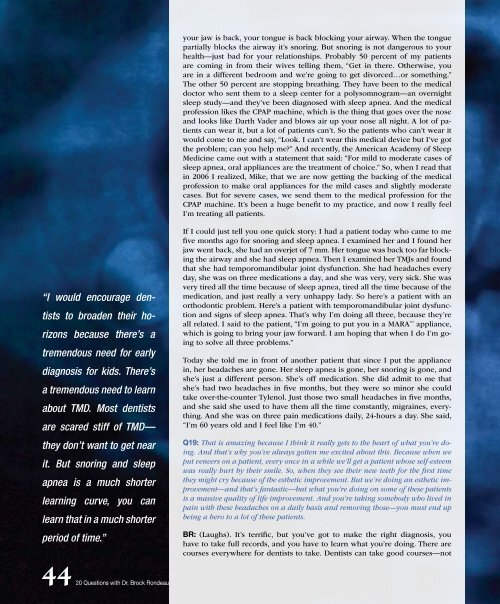Chairside - Glidewell Dental Labs
Chairside - Glidewell Dental Labs
Chairside - Glidewell Dental Labs
Create successful ePaper yourself
Turn your PDF publications into a flip-book with our unique Google optimized e-Paper software.
“I would encourage den-<br />
tists to broaden their ho-<br />
rizons because there’s a<br />
tremendous need for early<br />
diagnosis for kids. There’s<br />
a tremendous need to learn<br />
about TMD. Most dentists<br />
are scared stiff of TMD—<br />
they don’t want to get near<br />
it. But snoring and sleep<br />
apnea is a much shorter<br />
learning curve, you can<br />
learn that in a much shorter<br />
period of time.”<br />
44<br />
20 Questions with Dr. Brock Rondeau<br />
your jaw is back, your tongue is back blocking your airway. When the tongue<br />
partially blocks the airway it’s snoring. But snoring is not dangerous to your<br />
health—just bad for your relationships. Probably 50 percent of my patients<br />
are coming in from their wives telling them, “Get in there. Otherwise, you<br />
are in a different bedroom and we’re going to get divorced…or something.”<br />
The other 50 percent are stopping breathing. They have been to the medical<br />
doctor who sent them to a sleep center for a polysomnogram—an overnight<br />
sleep study—and they’ve been diagnosed with sleep apnea. And the medical<br />
profession likes the CPAP machine, which is the thing that goes over the nose<br />
and looks like Darth Vader and blows air up your nose all night. A lot of patients<br />
can wear it, but a lot of patients can’t. So the patients who can’t wear it<br />
would come to me and say, “Look. I can’t wear this medical device but I’ve got<br />
the problem; can you help me?” And recently, the American Academy of Sleep<br />
Medicine came out with a statement that said: “For mild to moderate cases of<br />
sleep apnea, oral appliances are the treatment of choice.” So, when I read that<br />
in 2006 I realized, Mike, that we are now getting the backing of the medical<br />
profession to make oral appliances for the mild cases and slightly moderate<br />
cases. But for severe cases, we send them to the medical profession for the<br />
CPAP machine. It’s been a huge benefit to my practice, and now I really feel<br />
I’m treating all patients.<br />
If I could just tell you one quick story: I had a patient today who came to me<br />
five months ago for snoring and sleep apnea. I examined her and I found her<br />
jaw went back, she had an overjet of 7 mm. Her tongue was back too far blocking<br />
the airway and she had sleep apnea. Then I examined her TMJs and found<br />
that she had temporomandibular joint dysfunction. She had headaches every<br />
day, she was on three medications a day, and she was very, very sick. She was<br />
very tired all the time because of sleep apnea, tired all the time because of the<br />
medication, and just really a very unhappy lady. So here’s a patient with an<br />
orthodontic problem. Here’s a patient with temporomandibular joint dysfunction<br />
and signs of sleep apnea. That’s why I’m doing all three, because they’re<br />
all related. I said to the patient, “I’m going to put you in a MARA appliance,<br />
which is going to bring your jaw forward. I am hoping that when I do I’m going<br />
to solve all three problems.”<br />
Today she told me in front of another patient that since I put the appliance<br />
in, her headaches are gone. Her sleep apnea is gone, her snoring is gone, and<br />
she’s just a different person. She’s off medication. She did admit to me that<br />
she’s had two headaches in five months, but they were so minor she could<br />
take over-the-counter Tylenol. Just those two small headaches in five months,<br />
and she said she used to have them all the time constantly, migraines, everything.<br />
And she was on three pain medications daily, 24-hours a day. She said,<br />
“I’m 60 years old and I feel like I’m 40.”<br />
Q19: That is amazing because I think it really gets to the heart of what you’re doing.<br />
And that’s why you’ve always gotten me excited about this. Because when we<br />
put veneers on a patient, every once in a while we’ll get a patient whose self-esteem<br />
was really hurt by their smile. So, when they see their new teeth for the first time<br />
they might cry because of the esthetic improvement. But we’re doing an esthetic improvement—and<br />
that’s fantastic—but what you’re doing on some of these patients<br />
is a massive quality of life improvement. And you’re taking somebody who lived in<br />
pain with these headaches on a daily basis and removing those—you must end up<br />
being a hero to a lot of these patients.<br />
BR: (Laughs). It’s terrific, but you’ve got to make the right diagnosis, you<br />
have to take full records, and you have to learn what you’re doing. There are<br />
courses everywhere for dentists to take. Dentists can take good courses—not

















